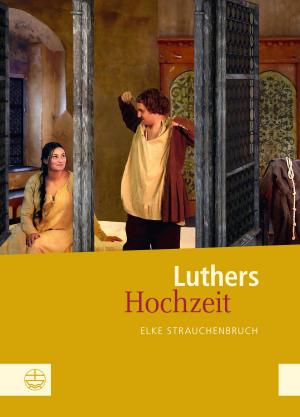| Author: | ISBN: | 9783374050697 | |
| Publisher: | Evangelische Verlagsanstalt | Publication: | April 30, 2019 |
| Imprint: | Evangelische Verlagsanstalt | Language: | German |
| Author: | |
| ISBN: | 9783374050697 |
| Publisher: | Evangelische Verlagsanstalt |
| Publication: | April 30, 2019 |
| Imprint: | Evangelische Verlagsanstalt |
| Language: | German |
Luthers Tod am 18. Februar 1546 in Eisleben markiert eine reformationsgeschichtliche Zäsur. Der auf eine Tagung zurückgehende Band thematisiert dieses Ereignis, indem die letzten Lebenstage Luthers, die Sterbeberichte, die Überführung nach Wittenberg und die Beisetzung in der Schlosskirche einer neuen Betrachtung unterzogen werden. Luthers Tod wird zugleich in die größeren kirchen- und kulturgeschichtlichen Zusammenhänge eingeordnet: Sterben und Tod werden im zeitgenössischen und reformatorischen Kontext ebenso erörtert wie die Frage nach der Witwe und den Nachkommen des Reformators. Einer der Schwerpunkte des Bandes liegt auf dem Prozess der Memorialisierung, der noch am Totenbett einsetzte und über die Einrichtung von Luthers vermeintlichem Eisleber Sterbehaus als Luthergedenkstätte bis zu den noch heute gebräuchlichen Formen der Luthermemorialisierung an runden Todesjahren reicht. Einen weiteren Schwerpunkt bilden die bis in das 20. Jahrhundert in großer Schärfe ausgetragenen konfessionellen Kontroversen, die sich an Luthers Tod und seine näheren Umstände anschlossen. Mit Beiträgen von Armin Kohnle, Volker Leppin, Heiner Lück, Siegfried Bräuer, Stefan Rhein und Klaus Fitschen. [Luther’s Death. Event and Effect] Luther’s death in Eisleben on February 18th, 1546, marks a break in the history of the Reformation. This volume, outcome of a conference, discusses this historical event by reconsidering and re-examining the last days of Luther, the reports of his death, the transfer to Wittenberg, and the burial in the Schlosskirche. At the same time the event is seen in the wider context of church and cultural history: by discussing dying and death in a contemporary and reformational context as well as considering the question of Luther’s widow and descendants. One of the focuses of this volume is on the process of memorialization which began already at the deathbed, followed later by the setting up of the alleged last residence in Eisleben as a Luther Memorial and by still common forms of Luther memorialization at important death anniversaries. A further focus is on the strong confessional controversies until the 20th century in connection with Luther’s death and its circumstances.
Luthers Tod am 18. Februar 1546 in Eisleben markiert eine reformationsgeschichtliche Zäsur. Der auf eine Tagung zurückgehende Band thematisiert dieses Ereignis, indem die letzten Lebenstage Luthers, die Sterbeberichte, die Überführung nach Wittenberg und die Beisetzung in der Schlosskirche einer neuen Betrachtung unterzogen werden. Luthers Tod wird zugleich in die größeren kirchen- und kulturgeschichtlichen Zusammenhänge eingeordnet: Sterben und Tod werden im zeitgenössischen und reformatorischen Kontext ebenso erörtert wie die Frage nach der Witwe und den Nachkommen des Reformators. Einer der Schwerpunkte des Bandes liegt auf dem Prozess der Memorialisierung, der noch am Totenbett einsetzte und über die Einrichtung von Luthers vermeintlichem Eisleber Sterbehaus als Luthergedenkstätte bis zu den noch heute gebräuchlichen Formen der Luthermemorialisierung an runden Todesjahren reicht. Einen weiteren Schwerpunkt bilden die bis in das 20. Jahrhundert in großer Schärfe ausgetragenen konfessionellen Kontroversen, die sich an Luthers Tod und seine näheren Umstände anschlossen. Mit Beiträgen von Armin Kohnle, Volker Leppin, Heiner Lück, Siegfried Bräuer, Stefan Rhein und Klaus Fitschen. [Luther’s Death. Event and Effect] Luther’s death in Eisleben on February 18th, 1546, marks a break in the history of the Reformation. This volume, outcome of a conference, discusses this historical event by reconsidering and re-examining the last days of Luther, the reports of his death, the transfer to Wittenberg, and the burial in the Schlosskirche. At the same time the event is seen in the wider context of church and cultural history: by discussing dying and death in a contemporary and reformational context as well as considering the question of Luther’s widow and descendants. One of the focuses of this volume is on the process of memorialization which began already at the deathbed, followed later by the setting up of the alleged last residence in Eisleben as a Luther Memorial and by still common forms of Luther memorialization at important death anniversaries. A further focus is on the strong confessional controversies until the 20th century in connection with Luther’s death and its circumstances.















